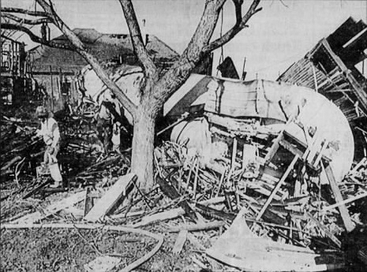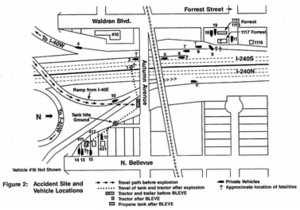Memphis tanker truck disaster facts for kids
Quick facts for kids Memphis tanker truck disaster |
|
|---|---|

The tank among damaged structures
|
|
| Details | |
| Date | December 23, 1988 c. 10:15am (CST) |
| Location | I-40/I-240 Midtown Interchange, Memphis, Tennessee |
| Coordinates | 35°09′05.6″N 90°01′17.3″W / 35.151556°N 90.021472°W |
| Country | United States |
| Incident type | Traffic collision, tanker truck explosion |
| Cause | Loss of control of tanker truck by driver, BLEVE |
| Statistics | |
| Vehicles | ~20 |
| Deaths | 9 |
| Injured | 10 |
The Memphis tanker truck disaster was a terrible accident that happened on December 23, 1988. A large truck, called a tanker truck, was carrying a gas called propane. It crashed on a highway exit ramp in Memphis, Tennessee.
The crash caused the truck's tank to break open, and the propane gas started to leak out. This gas then caught fire, causing a huge explosion. The explosion set many cars and buildings on fire. The tank itself was thrown about 114 meters (125 yards) away, landing in a neighborhood and starting more fires. Nine people sadly died, and ten people were hurt. The highway interchange where the accident happened was known for being unsafe. It was completely rebuilt years later.
What Was the Interchange Like?
The accident happened at a place where two major highways, I-40 and I-240, met in Midtown Memphis. This interchange was built in the late 1960s and opened in 1971.
It was originally designed to be a four-way interchange, meaning traffic could go in many directions. However, plans for I-40 changed because people didn't want it to go through a park called Overton Park. Lawsuits stopped the original plan.
Because of these changes, the interchange ended up with some ramps and bridges that were never used. The ramps that were used, especially the one where the accident happened, were very narrow and had sharp turns. The speed limit on this specific ramp was only 40 kilometers per hour (25 miles per hour).
At the time of the accident, this interchange was considered one of the most dangerous in Tennessee. It had many more crashes than other parts of the state's highways. The state transportation department had already started planning to rebuild it because it was so unsafe.
How Did the Accident Happen?
The truck involved in the accident was a 1986 Mack truck. It was pulling a large steel tank that held about 36,000 liters (9,511 gallons) of pressurized propane gas.
On December 23, 1988, around 10:15 in the morning, the truck was driving on I-40. It skidded off an exit ramp at the Midtown interchange. The truck rolled over and crashed into a wall at the bottom of an overpass.
The crash made a small hole in the front of the tank. The propane gas quickly leaked out and formed a large cloud around the highway. Seconds later, this gas cloud exploded. It was a type of explosion called a boiling liquid expanding vapor explosion (BLEVE).
The fireball from the explosion was huge, estimated to be about 213 meters (700 feet) wide and 213 to 244 meters (700 to 800 feet) tall. This explosion immediately set nearby cars and buildings on fire. Five people, including the truck driver, died instantly.
The force of the explosion also launched the truck's tank into the air. It hit a nearby bridge, bounced off the ground, hit a tree, and then crashed into a house about 114 meters (125 yards) away from the highway. This killed one person inside the house and started more fires that spread to other buildings and cars.
Parts of the truck, like tires and an axle, were thrown into nearby homes. The crash caused a huge traffic jam for miles. About an hour later, another truck crashed into stopped cars in the traffic jam on I-240, killing its driver.
In total, seven other cars were completely destroyed by the explosion. Ten other cars, seven houses, and one industrial building were damaged. Ten people were injured, and two people who were in homes hit by the tank died the next day from their injuries. Some of the people who died were burned so badly that they could not be recognized.
What Happened After the Accident?
Investigators from the National Transportation Safety Board arrived the day after the accident. They found that the truck had passed an inspection just the day before. The truck driver knew the route well. He had picked up the propane in West Memphis, Arkansas, and was going to Ellendale, which is about 32 kilometers (20 miles) northeast of Memphis.
Authorities identified the people who died. They included Randall Benson (the truck driver), Harrison G. Lee, Robert Wardlow, Tina Wiles, Warner Wiles, and David Bailey (the driver of the second truck). Shelanda Towles, Iva J. Rubesheim, and James M. Malone were the people who died in the homes hit by the explosion.
The National Fire Protection Agency (NFPA) also investigated the accident. They released their report in 1990. They couldn't say for sure what caused the propane to leak or exactly how it caught fire. They thought the fire might have started in a house that the gas cloud reached. They also thought the tank might have been punctured by a guardrail post when the truck rolled over.
Between 2003 and 2006, the Tennessee Department of Transportation spent $53 million to completely rebuild the dangerous interchange. The old, unused ramps and bridges were torn down. The new design made traffic flow much better and helped reduce crashes. This project was delayed for several years because the state needed to buy land from local residents, and some people didn't want to sell.


